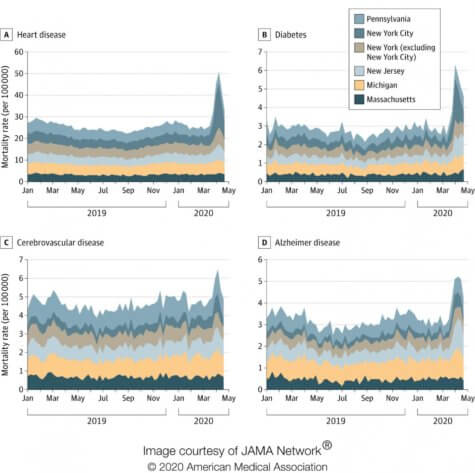RICHMOND, Va. — The coronavirus pandemic is causing the death rate in the United States to rise to horrifying levels. While many “excess deaths” can be traced directly to the virus, a new study finds a large number of Americans are dying from other causes.
Researchers at Virginia Commonwealth and Yale universities say the nation saw over 87,000 more deaths than the average for March and April. The report finds COVID-19 is directly responsible for only 65 percent of those fatalities. In 14 states, including California and Texas, more than half of the excess deaths were tied to a cause other than coronavirus.
Lead author Steven Woolf says some of these deaths may reflect medical officials under-reporting COVID-19 cases. Adding data can take time to get all the information to the public.
“Some cases might involve patients with COVID-19 who died from related complications, such as heart disease, and those complications may have been listed as the cause of death rather than COVID-19,” Woolf adds in a university statement.
COVID-19’s widespread effects leading to non-virus deaths
Woolf believes there could be another reason for the dramatic rise in non-coronavirus deaths: the pandemic’s impact on society has been just as devastating.

“A third possibility, the one we’re quite concerned about, is indirect mortality — deaths caused by the response to the pandemic,” explains Woolf, the director emeritus of VCU’s Center on Society and Health. “People who never had the virus may have died from other causes because of the spillover effects of the pandemic, such as delayed medical care, economic hardship or emotional distress.”
The study, published in the Journal of the American Medical Association, finds March and April deaths unrelated to COVID-19 rose sharply in the five states with the most COVID-19 fatalities. Those states include Massachusetts, Michigan, New Jersey, New York, and Pennsylvania.
Compared to January and February averages, diabetes deaths rose by 96 percent in those states. Deaths tied to heart disease (89%), Alzheimer’s disease (64%), and stroke (35%) also saw disturbing jumps. The study adds deaths in New York City due to heart disease and diabetes both rose by over 350 percent during that time.
Researchers believe fear of getting infected with COVID-19 is keeping many people from seeking proper medical care. The study adds patients in the hardest hit areas may not be getting enough care because local hospitals are overwhelmed with coronavirus cases.
“We can’t forget about mental health,” says Woolf. “A number of people struggling with depression, addiction and very difficult economic conditions caused by lockdowns may have become increasingly desperate, and some may have died by suicide.”
Coronavirus is not the country’s only emergency
Researchers say public officials in the U.S. need to make sure services stay visible and available for the many Americans dealing with issues other than COVID-19.
“The findings from our VCU researchers’ study confirm an alarming trend across the U.S., where community members experiencing a health emergency are staying home — a decision that can have long-term, and sometimes fatal, consequences,” Peter Buckley of VCU Health System says.
The emergency doesn’t end with healthcare. The study urges officials to also make more resources available to those dealing with unemployment, losses in income, and food or house insecurity during the crisis.
Like studies? Follow us on Facebook!
